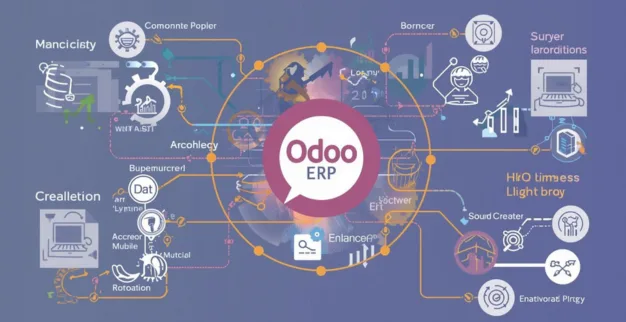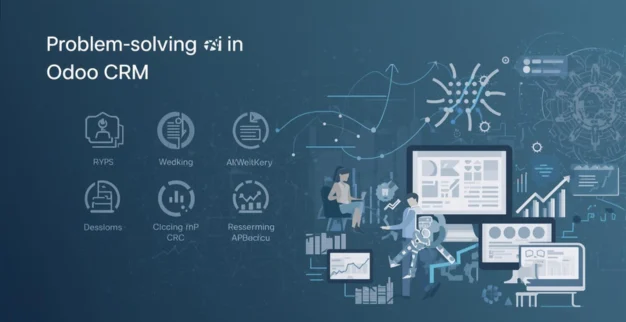How Odoo ERP Software Can Solve Your Business Management Challenges
By: Jai Krishnan
09 Oct 2025
Category: Odoo ERP Security
In today’s competitive and fast-moving business environment, companies of all sizes struggle with operational inefficiencies, data silos, lack of real-time insights, and fragmented systems. Many grow with standalone tools (Excel, isolated accounting software, separate CRM, inventory tools), and over time the complexity becomes a bottleneck.
This is where Odoo ERP software can become a game-changer. With its modular architecture and unified platform, Odoo aims to integrate all your core business functions in one system — from sales to inventory, accounting, HR, manufacturing, and more. In this article, we explore the common pain points in business management and how Odoo helps overcome them.
The Business Challenges Holding You Back
Here are the key challenges many organizations face as they grow:
Fragmented Systems & Data Silos
When each department (sales, operations, accounting, HR) uses its own tool, data duplication, inconsistent figures, and manual reconciliations are common.
Limited Real-Time Visibility
Decision makers often rely on delayed reports. By the time you compile data from all sources, it may no longer reflect the current state.
Manual & Repetitive Processes
Tasks such as invoice creation, purchase approvals, stock reorder, and report generation often remain manual, increasing errors and delays.
Poor Collaboration & Communication
Teams communicate via emails, spreadsheets, or external tools, making traceability difficult and leading to misalignment.
Scalability & Flexibility Issues
When your business changes (new workflows, new divisions, different markets), rigid legacy systems often struggle to adapt.
High Maintenance & Integration Costs
Integrating multiple systems, maintaining custom connectors, managing security, updates—all this adds technical overhead and cost.
Inconsistent Data & Errors
When data is duplicated across systems or manually entered multiple times, errors creep in, reducing trust in reports.
How Odoo ERP Addresses These Challenges
Here’s how Odoo helps resolve the above issues and enable more efficient, transparent, and scalable operations:
1. Unified, Integrated Platform
All modules in Odoo—CRM, Sales, Purchasing, Inventory, Manufacturing, Accounting, HR, Projects, Marketing, and more—are designed to work together out-of-the-box. So a sales order flows into inventory, triggers delivery, posts accounting entries, and updates dashboards—without glue code.
This eliminates data silos and ensures consistency across departments.
2. Real-Time Dashboards and Reporting
With Odoo’s built-in reporting and dashboard tools, executives and managers can view key metrics instantly: sales pipeline, cash flow, stock levels, project progress, and more. Drill-downs help you trace root causes without waiting for manually compiled reports.
3. Automation of Workflow & Tasks
Odoo enables you to automate recurring tasks and approvals:
- Auto-generate invoices once delivery is confirmed
- Trigger purchase orders when stock drops below set thresholds
- Automate expense claims approval based on rules
- Send reminders for overdue payments or tasks
Reducing repetitive manual work frees your teams to focus on strategic tasks.
4. Better Collaboration & Traceability
Each record in Odoo (a sale, purchase, ticket, project) supports internal chatter, attachments, notes, and linking to related records. Team members can see the full history, context, and communication in one place. This reduces context switching and miscommunication.
5. Modular & Scalable Growth
You don’t have to implement every Odoo module at once. Start with core modules (e.g. CRM, Sales, Accounting), then expand by adding Inventory, Manufacturing, HR, etc., as your business demands. You can also customize modules or use apps from the Odoo App Store to suit your domain specifics.
6. Reduced Integration Overheads
Because Odoo modules are designed to integrate natively, you need fewer external connectors or custom middleware. Maintenance, updates, and security are managed centrally. That greatly lowers the technical overhead and cost compared to stitching together disparate systems.
7. Accuracy & Reliability of Data
With a “single source of truth,” your reporting is based on one consistent database. Eliminating manual duplication reduces errors and builds confidence in your operational metrics.
8. Mobile & Cloud Accessibility
Odoo supports responsive web clients and mobile usage. Whether your employees are in warehouses, offices, or out in the field, they can access the system from tablets or smartphones. Cloud deployment ensures uptime, scalability, and remote access.
Use Cases: Odoo in the Real World
Here are a few scenarios of how different businesses leverage Odoo to solve real challenges:
Retail & E-Commerce
A retailer integrates its online shop, point-of-sale (POS), and warehouse. Inventory syncs in real time; sales, returns, and accounting update automatically.
Manufacturing / Industrial
A factory uses the Manufacturing (MRP) module to plan production, manage work orders, control BOMs (Bills of Materials), and integrate with sales forecasting.
Service / Consulting Firms
A consulting firm uses Projects, Timesheets, and Invoicing. Staff enter time; invoices generate automatically. You also track project profitability by client or task.
Wholesale / Distribution
A distributor automates procurement, inventory replenishment, order fulfillment, and accounting reconciliation. Stock-outs and overstocks get minimized.
Multi-entity / Multi-warehouse Businesses
Businesses managing multiple subsidiaries or warehouses can use Odoo’s multi-company support, inter-unit transfers, and consolidated reporting to manage complexity.
Implementation Best Practices & Tips
To get the full benefits of Odoo, follow these best practices:
- Begin with a Pilot / Core Modules: Don’t try to switch everything at once. Start with core modules (CRM, Sales, Accounting) and expand gradually.
- Clean & Standardize Data Before Migration: Ensure your customer list, products, inventory, chart of accounts, etc., are cleaned and standardized before importing to Odoo.
- Define Your Processes Before Configuring: Even though Odoo is flexible, having defined workflows (approval structures, stock flows, return policies) helps guide configuration and avoid chaos.
- Train Users Thoroughly: Provide role-based training, documentation, and a support mechanism. Early buy-in is critical for adoption.
- Iterate After Go-Live: After deployment, collect user feedback and continuously refine workflows, automations, and interface tweaks.
- Leverage an Expert Implementation Partner: Working with a certified Odoo partner can accelerate implementation, provide domain best practices, and reduce risk.
- Plan for Governance & Maintenance: Establish who can change workflows, approve customizations, manage updates, and provide support.
Why Odoo Stands Out vs Other ERP Tools
| Feature |
Odoo Benefit |
Typical Alternative Trade-off |
| All-in-one suite |
One vendor, unified modules |
Many vendors and integrations |
| Modular & scalable |
Add modules as you grow |
Rigid systems, harder to scale |
| Open-core / cost-effective |
Lower licensing / upgrade burden |
Higher license fees or hidden costs |
| Flexible customization |
Adapt to your unique workflows |
Customization often expensive or limited |
| Strong community & app ecosystem |
Many community modules and support |
Smaller marketplaces or lock-in |
Challenges to Watch & How to Mitigate
While Odoo is powerful, implementations can fail or underdeliver if oversight is lacking. Here are potential risks and mitigation tips:
- Over-customization: Too many custom modules can make upgrades difficult.
Mitigation: Favor configuration over coding; document custom features.
- User Resistance: Users may resist change or continue using old tools.
Mitigation: Engage users early, provide training, and show value.
- Poor Data Migration: Bad data inputs lead to errors downstream.
Mitigation: Validate data rigorously, run test migrations, and clean before go-live.
- Scope Creep & Delays: Trying to do too much in phase 1 can derail implementation.
Mitigation: Use phased rollouts; control change requests.
- Governance & Maintenance: Who controls changes, updates, backups, and support?
Mitigation: Establish clear roles and processes for system administration.


